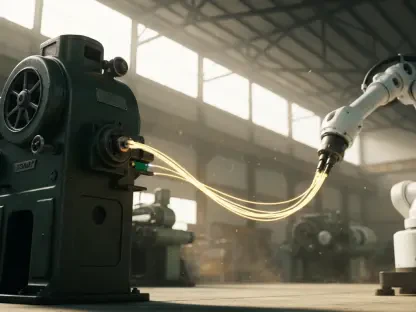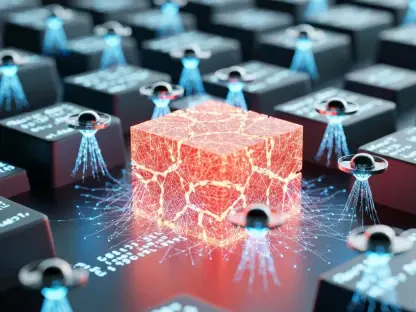Imagine a robot so flexible it can slither through the tightest of spaces, mimicking the delicate precision of human fingers while performing tasks as intricate as cleaning narrow pipelines or assisting in life-saving surgeries. This is no longer a vision of science fiction but a reality driven by the burgeoning field of muscle-inspired soft robotics. This innovative trend is reshaping the boundaries of technology by addressing the critical shortcomings of traditional rigid robots, particularly in industries demanding adaptability and finesse such as healthcare and manufacturing. The significance of this development lies in its potential to revolutionize how robots interact with complex environments, offering solutions where strength and flexibility must coexist. This analysis delves into the emergence of muscle-inspired designs, explores real-world applications, highlights expert insights, and examines the future potential of this transformative technology, providing key takeaways for understanding its impact.
The Rise of Muscle-Inspired Soft Robotics
Growth and Adoption Trends in Soft Robotics
The field of soft robotics has witnessed remarkable growth in recent years, fueled by increasing investments and research focus. According to industry reports, global funding for soft robotics technologies has surged, with projections estimating a significant rise in market value over the next few years from 2025 onward. This financial backing reflects a broader shift from rigid, metal-based robotic systems to flexible, adaptable alternatives, particularly in sectors like medical technology and industrial automation where precision is paramount. The adoption rate in these industries highlights a growing recognition of soft robots’ ability to perform tasks that traditional models cannot, such as navigating delicate human tissues or confined industrial spaces.
A key driver behind this momentum is the bio-inspired approach, with muscle-inspired designs emerging as a prominent subset. These systems, modeled after natural mechanisms like human muscle contractions, are gaining traction for their unique ability to combine pliability with controlled strength. Research institutions and tech companies are increasingly prioritizing such designs, evident in the rising number of patents and academic publications dedicated to mimicking biological systems. This trend underscores a pivotal shift toward robotics that can emulate nature’s efficiency and adaptability.
The implications of this growth are vast, as industries begin to integrate soft robotics into mainstream applications. From surgical tools to automated inspection devices, the transition to flexible systems is not merely a technological upgrade but a fundamental rethinking of robotic capabilities. This evolution positions muscle-inspired robotics as a cornerstone of innovation, promising to redefine operational standards across multiple fields.
Real-World Breakthroughs and Case Studies
One of the most groundbreaking advancements in this domain comes from a leading research team at Pohang University of Science and Technology (POSTECH), which developed a thin, sheet-like robotic actuator inspired by the human muscle protein myosin. Published in a prestigious scientific journal, their work showcases a pneumatic actuator that replicates muscle mechanics through a complex network of air chambers, enabling multi-directional movement. This design allows the robot to bend, crawl, and navigate confined spaces with unprecedented agility, setting a new benchmark for soft robotic performance.
Testing of this actuator revealed extraordinary capabilities, including the precision to manipulate objects akin to human fingers and the resilience to operate underwater. Its ability to clean narrow pipelines demonstrates practical utility in industrial settings, while its flexibility suggests potential for delicate medical procedures. Such versatility highlights how muscle-inspired technology can address challenges that rigid robots fail to overcome, offering solutions for environments requiring both gentleness and accuracy.
Beyond this specific innovation, other notable advancements in soft robotics further illustrate the field’s breadth. Several companies and research groups are exploring similar bio-inspired technologies, developing robots for applications ranging from agricultural harvesting to disaster response. These case studies collectively emphasize that muscle-inspired designs are not isolated experiments but part of a broader movement toward creating robots that mirror nature’s adaptability, paving the way for widespread real-world impact.
Expert Perspectives on Bio-Inspired Robotics
Insights from the POSTECH research team shed light on the intricacies of muscle-inspired technology. Professor Keehoon Kim has emphasized the critical role of integrating complex pneumatic networks into flexible structures, enabling multi-directional motion that mimics natural muscle behavior. His perspective underscores the importance of such designs in achieving controlled, precise movements, a feat traditional robotics struggles to replicate. This approach, according to the team, marks a significant step toward overcoming long-standing limitations in robotic functionality.
Other industry leaders and robotics experts echo this sentiment, highlighting the dual challenge of balancing flexibility with sufficient strength. Many note that while soft materials offer unparalleled adaptability, ensuring durability and power remains a hurdle. However, there is widespread agreement on the transformative potential of mimicking natural muscle mechanics, with experts pointing to applications that could redefine human-robot collaboration in sensitive tasks like surgery or caregiving. This consensus reflects optimism about the role of bio-inspired designs in pushing technological boundaries.
The broader significance of this trend lies in its capacity to open new frontiers for robotic applications. Experts collectively view muscle-inspired soft robotics as a paradigm shift, capable of addressing unmet needs in environments where rigidity is a barrier. Their insights suggest that continued innovation in this area could lead to robots that not only perform tasks but also interact with the world in ways previously thought impossible, blending seamlessly into human-centric spaces.
Future Horizons for Muscle-Inspired Soft Robotics
Looking ahead, the field of muscle-inspired soft robotics holds immense promise, with potential advancements poised to enhance both design and application. Improved mathematical models for predicting robot movements are on the horizon, offering a foundation for more precise control and scalability across diverse uses. Such developments could enable the creation of robots tailored for specific tasks, from intricate medical interventions to robust industrial operations, amplifying their effectiveness in real-world scenarios.
The anticipated benefits of these innovations are transformative, particularly in healthcare where soft robots could revolutionize minimally invasive surgeries by navigating tiny bodily openings with minimal disruption. In industrial settings, enhanced safety during inspections of hard-to-reach areas is a key advantage, reducing risks to human workers. Additionally, the prospect of intuitive home robots for caregiving or cleaning tasks points to a future where human-robot interactions become more natural and supportive, reshaping daily life.
Nevertheless, challenges remain, including the durability of soft materials under repeated stress and the high costs associated with production. Broader implications, such as ethical concerns in medical applications and the need for regulatory frameworks, also warrant attention. While optimistic scenarios envision widespread adoption transforming industries, potential hurdles like technical limitations could slow progress. Balancing these factors will be crucial to realizing the full scope of muscle-inspired robotics, ensuring that innovation aligns with practical and societal needs.
Conclusion: Embracing the Soft Robotics Revolution
Reflecting on the journey of muscle-inspired soft robotics, it becomes evident that the innovative design of actuators mimicking human muscle mechanics marks a turning point in technological advancement. Their proven capabilities in navigating tight spaces and performing delicate tasks, coupled with validation from experts, underscore their value. The promise of future applications across healthcare, industry, and domestic settings further solidifies their importance as a game-changer in addressing the need for flexibility and precision.
Moving forward, the focus shifts to actionable steps such as fostering interdisciplinary collaboration between engineers, material scientists, and ethicists to tackle challenges like durability and cost. Investing in research to refine predictive models emerges as a priority to enhance scalability. As this field continues to evolve, stakeholders are encouraged to explore partnerships that could accelerate the integration of soft robotics into everyday solutions, ultimately transforming how technology supports human endeavors across diverse landscapes.









